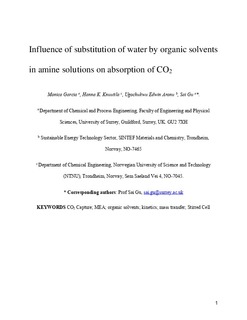| dc.contributor.author | Garcia, Monica | |
| dc.contributor.author | Knuutila, Hanna K | |
| dc.contributor.author | Aronu, Ugochukwu Edwin | |
| dc.contributor.author | Gu, Sai | |
| dc.date.accessioned | 2019-08-16T11:07:52Z | |
| dc.date.available | 2019-08-16T11:07:52Z | |
| dc.date.created | 2018-09-27T16:39:46Z | |
| dc.date.issued | 2018 | |
| dc.identifier.citation | International Journal of Greenhouse Gas Control. 2018, 78 286-305. | nb_NO |
| dc.identifier.issn | 1750-5836 | |
| dc.identifier.uri | http://hdl.handle.net/11250/2608750 | |
| dc.description.abstract | Aqueous amine solutions are the most used solvents for chemical absorption of CO2. Substituting part of the water by organic solvents in aqueous amine solutions aims to take advantage of the lower partial pressure and higher CO2 solubility. In this work, the influence of four organic solvents on solution density, viscosity, N2O solubility and absorption kinetics are studied. The organic solvents, Monoethylene Glycol (MEG), Diethylene Glycol (DEG), Triethylene Glycol (TEG) and CARBITOL, are blended with two amine solutions: MEA and DEEA-MAPA blend. The results show that the addition of organic solvents increases the density and viscosity. Furthermore, the N2O solubility, used to estimate the physical solubility of CO2 into a reactive system, increases when part of the water is substituted with an organic solvent. The kinetic experiments with a double stirred cell showed that in case of aqueous 5 M MEA, the substitution of part of the water increases both the mass transfer and kinetic coefficients of the CO2, whereas the substitution in the 3M DEEA + 2M MAPA solution was not that favorable and only the substitution of MEG showed enhancement on the mass transfer and kinetic coefficients over the whole temperature range studied. The results can be partly explained by the changes in viscosity and N2O solubility in the different systems, since the viscosity of the MEA organic solvent blends is lower compared to that of DEEA + MAPA blends and have less negative influence on the kinetics. At the same time, the increase of N2O solubility in the MEA blends is much higher than in DEEA + MAPA blends, resulting in more CO2 available to react. Finally, the kinetic coefficients results are discussed together with dielectric constant of the dilution media. | nb_NO |
| dc.language.iso | eng | nb_NO |
| dc.publisher | Elsevier | nb_NO |
| dc.relation.uri | https://www.sciencedirect.com/science/article/pii/S175058361731037X | |
| dc.rights | Attribution-NonCommercial-NoDerivatives 4.0 Internasjonal | * |
| dc.rights.uri | http://creativecommons.org/licenses/by-nc-nd/4.0/deed.no | * |
| dc.title | Influence of substitution of water by organic solvents in amine solutions on absorption of CO2 | nb_NO |
| dc.type | Journal article | nb_NO |
| dc.type | Peer reviewed | nb_NO |
| dc.description.version | acceptedVersion | nb_NO |
| dc.source.pagenumber | 286-305 | nb_NO |
| dc.source.volume | 78 | nb_NO |
| dc.source.journal | International Journal of Greenhouse Gas Control | nb_NO |
| dc.identifier.doi | 10.1016/j.ijggc.2018.07.029 | |
| dc.identifier.cristin | 1615267 | |
| dc.relation.project | Norges forskningsråd: 239789 | nb_NO |
| dc.description.localcode | © 2018. This is the authors’ accepted and refereed manuscript to the article. Locked until 11.9.2020 due to copyright restrictions. This manuscript version is made available under the CC-BY-NC-ND 4.0 license http://creativecommons.org/licenses/by-nc-nd/4.0/ | nb_NO |
| cristin.unitcode | 194,66,30,0 | |
| cristin.unitname | Institutt for kjemisk prosessteknologi | |
| cristin.ispublished | true | |
| cristin.fulltext | preprint | |
| cristin.qualitycode | 2 | |

